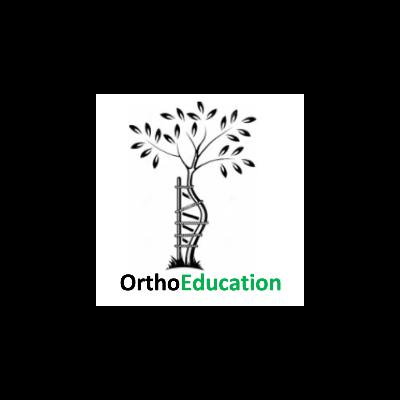Discover OrthoEducation
OrthoEducation

OrthoEducation
Author: OrthoEducation
Subscribed: 1Played: 2Subscribe
Share
Description
Welcome to the OrthoEducation Podcast Channel! We’re a 501(c)(3) nonprofit on a mission to empower patients with easy-to-understand, accurate, and bias-free info about orthopedic conditions. Our fun, informative episodes—powered by expert content and AI magic—break down everything from knee pain to tennis elbow. Whether you're newly diagnosed or just curious, we’ll help you become an active, informed partner in your own care. Each episode is rooted in peer-reviewed research from www.orthoeducation.com and designed to be clear, helpful, and never boring. Tune in, learn something new, and take charge of your orthopedic health—one episode at a time!
30 Episodes
Reverse
Why do so many pitchers face the dreaded “Thrower’s Elbow”? In this episode, The Thrower’s Curse: Inside Tommy John Surgery, we take a deep dive into one of the most well-known injuries in sports — the ulnar collateral ligament (UCL) tear — and the groundbreaking surgery that changed the game. You’ll learn how this crucial ligament in the elbow is injured, how doctors diagnose and treat it, and why Tommy John surgery has given countless athletes a second chance at success.From overuse on the mound to cutting-edge surgical reconstruction and year-long rehabilitation, this episode unpacks the science, the history, and the comeback stories behind the injury that reshaped baseball — and sports medicine.This podcast is based on information from the free, peer-reviewed website of the non-profit OrthoEducation, available at OrthoEducation.com.
Do your legs ache or feel numb when you stand or walk, but get better when you sit or lean forward? You might be experiencing lumbar spinal stenosis — a condition where the lower spinal canal narrows and puts pressure on the nerves. In this episode, we break down what lumbar spinal stenosis is, why it happens, and who’s most likely to develop it. You’ll learn how doctors diagnose it, the difference between conservative and surgical treatments, and why simple movements like bending forward can bring relief.Join us as we explore the causes, symptoms, and treatment options for this common spine condition in language that’s easy to understand.All information in this episode comes from OrthoEducation.com, the free, peer-reviewed website of the non-profit OrthoEducation, dedicated to helping patients better understand their musculoskeletal health through accurate and accessible education.
Why does your shoulder suddenly feel stiff and painful, like it’s stuck in place? In this episode, Frozen Shoulder Explained: Breaking Free from Shoulder Stiffness, we uncover what really happens when the shoulder “freezes.” Learn how adhesive capsulitis develops, why it can take months to recover, and what treatments truly help. We’ll explain the three stages of frozen shoulder—freezing, frozen, and thawing—and how physical therapy, stretching, and patience can gradually restore motion. You’ll also hear how doctors diagnose the condition, when injections or surgery might be used, and what most people can expect for long-term recovery.This episode is based on expert-reviewed information from the free, peer-reviewed website of the non-profit OrthoEducation, available at OrthoEducation.com. Whether you’re dealing with frozen shoulder yourself or helping someone through it, this podcast will help you understand how to get moving again—slowly, safely, and successfully.
Why does the front of your knee ache when you run, climb stairs, or sit too long? In this episode of Inside the Kneecap: Unpacking Anterior Knee Pain, we break down what’s really going on when the front of your knee starts to hurt. From patellofemoral pain syndrome—often called “runner’s knee”—to chondromalacia and other causes of anterior knee pain, we explore how these conditions develop, how they differ, and what you can do to find relief. Learn how doctors diagnose the problem, why physical therapy is often the key to recovery, and when surgery might actually be needed.This episode draws from expert-reviewed information available on the free, peer-reviewed website of the non-profit OrthoEducation, found at OrthoEducation.com. Whether you’re an athlete, weekend warrior, or just dealing with stubborn knee pain, this conversation helps you understand what’s happening inside the kneecap—and how to get back to pain-free movement.
Ever felt your finger “lock” when you try to straighten it — almost like it’s stuck on a trigger? In this episode, we explore Trigger Finger, a common hand condition that causes pain, stiffness, and a clicking or snapping sensation when bending or straightening a finger. You’ll learn why this happens, who’s most at risk (hint: it’s more common in people who use their hands repetitively or have conditions like diabetes or rheumatoid arthritis), and how doctors diagnose and treat it.From simple solutions like rest, splints, and anti-inflammatory medication to quick, effective surgical options — we’ll break down what works, what doesn’t, and why most people regain smooth, pain-free motion.This episode is based on trusted, peer-reviewed information from OrthoEducation, a free educational website run by the non-profit OrthoEducation.com, dedicated to making orthopaedic knowledge clear and accessible for everyone.
Ever wonder why your ankle feels stiff, sore, or painful with every step? In this episode of The Ankle Arthritis Deep Dive: What Patients Need to Know, we explore one of the most underappreciated causes of chronic ankle pain—ankle arthritis.Join us as we unpack what happens when the smooth cartilage of the ankle wears away, why past injuries can set the stage for arthritis, and how issues like misalignment, rheumatoid arthritis, or even gout can add to the problem. We’ll discuss what ankle arthritis looks like on X-rays, what symptoms to watch for, and—most importantly—the full range of treatments available, from simple lifestyle changes and bracing to advanced surgical options like ankle fusion and ankle replacement.This episode is based on expert-reviewed information from OrthoEducation, a free, non-profit, peer-reviewed educational website dedicated to helping patients and healthcare professionals better understand orthopaedic conditions.
Shoulder pain can be confusing, and the rotator cuff is often at the center of it. In this episode, we break down the full spectrum of rotator cuff problems—from early irritation and inflammation, to tendonitis, acute tears, chronic degenerative damage, and finally, shoulder arthritis caused by longstanding tears. You’ll learn how these problems develop, the symptoms they cause, and how doctors approach treatment at each stage—whether that’s rest, physical therapy, injections, surgical repair, or even shoulder replacement in severe cases.Our goal is to make sense of this complex topic in a way that’s clear, engaging, and useful for patients, families, and anyone interested in better understanding shoulder health. This podcast is brought to you by OrthoEducation, a nonprofit dedicated to creating free, peer-reviewed, and easy-to-understand patient education resources. Explore more at OrthoEducation.com.
Wrist fractures—also called distal radius fractures—are among the most common broken bones, often happening when someone falls on an outstretched hand. But not all wrist fractures are the same. In this episode, we break down the different types, including Colles, Smith, Barton, and intra-articular fractures, and explain how doctors diagnose them, from the first exam to X-rays and sometimes CT scans. We’ll walk through treatment options, from simple casting and closed reduction to surgery with plates, screws, or pins when the break is more complex. Finally, we’ll explore what recovery looks like, why physical therapy matters, and what patients can expect long-term in terms of wrist motion and strength.This podcast is brought to you by OrthoEducation, a non-profit organization dedicated to creating high-quality, easy-to-understand, peer-reviewed patient education resources. Learn more at OrthoEducation.com.
Osteoporosis is often called the “silent bone thief” because it can weaken bones without obvious symptoms—until a fracture occurs. In this episode, we break down what osteoporosis is, why it develops, and who is most at risk. You’ll learn how bone density changes with age, how factors like menopause, family history, smoking, and vitamin D deficiency play a role, and why fractures of the wrist, hip, shoulder, and spine are the most common red flags.We’ll also explain how doctors diagnose osteoporosis with bone density scans, the lifestyle changes that can help protect your bones, and the role of medications and physical therapy in treatment. Whether you’re looking to prevent osteoporosis or better understand your options after a diagnosis, this podcast provides clear, practical information you can use.This podcast is based on content from OrthoEducation.com, the free, peer-reviewed website of the non-profit OrthoEducation, dedicated to creating high-quality, easy-to-understand patient education resources.
Why does the strongest tendon in your body sometimes become your biggest weakness? In this episode, we dive into Achilles tendonitis, a painful condition that causes swelling and stiffness in the tendon at the back of your ankle. You’ll learn why it often strikes active people in their 30s and 40s, what puts you at risk, and how to spot the difference between classic (non-insertional) and insertional tendonitis. We’ll break down how doctors make the diagnosis, the role of tight calf muscles and activity changes, and—most importantly—what you can do to heal. From simple shoe modifications and stretching routines to progressive strengthening exercises, we’ll cover proven strategies for recovery and safe return to activity.This podcast comes from OrthoEducation, a non-profit dedicated to providing free, peer-reviewed, easy-to-understand resources for patients at OrthoEducation.com.
When the Collarbone Cracks dives into one of the most common broken bones: the clavicle, or collarbone. Whether from a hard fall, a sports collision, or an accident, this injury can leave patients with pain, swelling, and difficulty moving their arm. In this episode, we explore what a clavicle fracture is, why it happens, how doctors diagnose it, and the different treatment options—from simple slings and physical therapy to surgery with plates and screws. We’ll also discuss the recovery process, possible complications, and what most patients can expect long term.All of the information in this podcast comes from OrthoEducation.com, the free, peer-reviewed website of the non-profit OrthoEducation, dedicated to providing clear and reliable orthopedic education.
Why is there a squishy bump on your wrist—and should you be worried? In this episode we uncover the mystery behind ganglion cysts of the wrist—those jelly-like lumps that seem to show up out of nowhere. Whether you're a gymnast, an office warrior, or just curious about that strange bump, this episode is for you.We’ll break down what ganglion cysts are, why they form, how they’re diagnosed, and what to do if they’re painful or getting in the way. From simple observation to aspiration and surgery, we’ll cover the full spectrum of care with clear, practical insights.All the information in this episode comes from the free, peer-reviewed website of the non-profit OrthoEducation, available at OrthoEducation.com.So tune in and join us as we crack the code behind the most common wrist lump out there!
Why does a healthy spine start to curve during the teenage years—and what can be done about it?In this episode, we break down Adolescent Idiopathic Scoliosis —a common condition where the spine curves sideways for reasons that aren’t fully understood. You’ll learn how scoliosis is diagnosed, the different types of spinal curves, and how doctors decide whether to monitor, brace, or operate. We’ll also explain why this condition often shows up during growth spurts and why girls are more commonly affected.From Cobb angles to curve types, braces to back surgery—we’ve got you covered. All information in this episode comes from the free, peer-reviewed website of the non-profit OrthoEducation, available at OrthoEducation.com.Whether you're a parent, a patient, or just spine-curious, tune in for a clear and friendly guide to understanding scoliosis—no medical degree required!
Why does the outside of your hip ache when you lie on your side or go for a run? In this OrthoEducation podcast The Hip’s Outside Edge: The Trochanteric Bursitis Breakdown, we dive into the causes, symptoms, and treatments of trochanteric bursitis—a common source of outer hip pain, especially in women and older adults. Whether it's from repetitive motion, a tight IT band, or a direct hit to the hip, this condition can seriously cramp your stride. We’ll cover how it’s diagnosed, why surgery is rarely needed, and the best ways to calm that cranky bursa with stretching, therapy, and targeted treatments. All the information in this episode comes from the free, peer-reviewed, non-profit website OrthoEducation, available at OrthoEducation.com. Tune in for expert insights and tips to get your hip back on track!
Ever twisted your knee and felt a sharp pain or a sudden "pop"? You might be dealing with a meniscal tear, one of the most common knee injuries. In this episode, we explore what happens when the knee’s shock absorbers—the menisci—get torn. We break down the different types of meniscal tears, how they’re diagnosed, and what treatment options are available, from rest and rehab to arthroscopic surgery.Whether the tear is acute from a sudden sports injury or degenerative from years of wear and tear, we’ll guide you through how doctors assess the damage and decide on the best plan forward. You’ll also learn why the location and shape of a tear matter, and why not all torn menisci are treated the same way.All the information in this episode is based on peer-reviewed content from OrthoEducation.com—a free educational website created by the non-profit OrthoEducation to provide accurate, accessible orthopedic information to patients and learners alike.If your knee's been clicking, locking, or just not feeling right—this is the episode for you.
What really happens when your shoulder “pops out”? In this episode, we explore the world of acute shoulder dislocations—a painful but common injury, especially among athletes and active individuals. From how it happens (think: hard falls or awkward tackles) to how it’s diagnosed, treated, and rehabbed, we break it all down in a way that’s easy to understand and practical for patients, students, and curious minds alike.You’ll learn what it means to suffer a traumatic shoulder dislocation, how doctors get it back in place (safely), when surgery is needed, and why younger people are more likely to experience repeat dislocations. Plus, we cover what to expect during recovery and physical therapy.All of the information in this episode is based on peer-reviewed content from OrthoEducation.com—a free educational website created by the nonprofit OrthoEducation to provide clear, trustworthy orthopedic information to the public.Whether you're an athlete, a student, or just someone with a sore shoulder, this episode is a great place to start.
Why do your fingers tingle or go numb after typing or holding tools? In this episode, we take a deep dive into carpal tunnel syndrome, a common condition caused by pressure on the median nerve in the wrist. You’ll learn how it develops, how it’s diagnosed, and the range of treatments—from wrist splints and activity changes to carpal tunnel release surgery.This episode is based on trusted, peer-reviewed information from OrthoEducation.com—a free educational resource created by the non-profit OrthoEducation to help people better understand orthopedic conditions. Whether you're experiencing symptoms or just curious about your hand and wrist health, this episode offers clear, easy-to-understand insights grounded in expert knowledge.
Whiplash—it’s more than just a dramatic movie title. In this episode of OrthoEducation, we break down the real story behind one of the most common (and commonly misunderstood) neck injuries: whiplash, also known as acute cervical strain. Whether you’ve been in a fender bender or just want to understand that sudden post-injury neck pain, this episode walks you through what actually happens in a whiplash injury, what symptoms to look out for, how it’s diagnosed, and—most importantly—how to treat it.We’ll cover what tests are (and aren’t) needed, why rest is good but movement is better, and how early physical therapy can help you bounce back. Join us as we unpack the science, bust the myths, and offer a simple, straightforward path to recovery—all from a trusted non-profit committed to patient education. Your neck will thank you.
Is that bump on your big toe just a cosmetic issue—or something more? In this episode of FootEducation, we dive into the world of bunions—a common but often misunderstood foot condition. You’ll learn what bunions really are (hint: it’s more than just a bump), why they develop (no, it’s not just your shoes), and what treatment options actually work. From family history and bone alignment to bunion pads, shoe tips, and surgery do’s and don’ts—we cover it all in simple, clear language.Whether you’re dealing with a painful bunion, wondering if surgery is right for you, or just curious about what’s going on with your feet, this episode is for you. Hosted by FootEducation, a section of OrthoEducation—a non-profit committed to high-quality, easy-to-understand patient education.Walk away with the facts—not the myths—about bunions.
Foot pain slowing you down? In this episode of OrthoEducation, we’re diving into a tiny bone that can cause some big problems—your navicular. While not too common navicular stress fractures typically occur in runners, jumpers, and active folks. It is a sneaky injury that often starts with subtle pain and worsens if ignored. We’ll break down what the navicular bone is, why stress fractures happen, how to know if you have one, and what treatments—from rest to surgery—can get you back on your feet. Whether you’re an athlete, a weekend warrior, or just someone curious about foot health, this episode is packed with easy-to-understand info to help you stay active and informed. OrthoEducation is a nonprofit dedicated to creating clear, helpful resources for patients—no confusing jargon, just real talk about your bones and joints. Tune in to learn why small bones deserve big attention!














